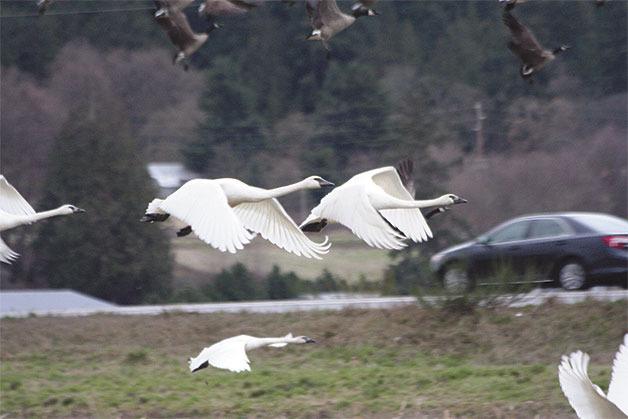The cacophony of honks rising from Dugualla Bay Farm is evidence that more trumpeter swans are wintering this year on Whidbey than in recent years.
More than 100 swans have been counted by state wildlife officials at the North Whidbey spot, double the usual number.
There’s a couple of reasons for this, according to Ralph Downes, a Washington Department of Fish and Wildlife enforcement officer.
First, the swans are continually altering their migration patterns based on where the best habitat is, Downes said.
“They find greener and greener pastures,” Downes said. “They’re basically looking for good habitat where they can rest, hunt and feed. It’s not set in stone.”
Second, the overall number of swans regionally is on the “upswing,” according Paul DeBruyn, a wildlife biologist with the Department of Fish and Wildlife.
Nearly extinct in the lower 48 states at the turn of 20th century, that population has now grown to 46,000 in North America, according to the National Park service.
“The trumpeter swans are really an interesting story,” said Joe Sheldon, a longtime volunteer and instructor with the Whidbey Audubon Society.
Despite the heavy hunting practices that nearly decimated the species, Sheldon said the swan has made a miraculous comeback because of protections put in place, both for the bird and its habitats. In addition, a very successful breeding cycle in the Canadian tundra has resulted an influx in population this year.
“It’s one of the true success stories,” Sheldon said.
A large percentage of the swans winter in the Pacific Northwest, DeBruyn said, and are drawn to farms as a resting spot while in proximity to open water where they can fish.
While a total of 120 swans were counted on Whidbey recently, Skagit County remains the premier wintering site in the region for the trumpeter, numbering in the 11,000s there.
DeBruyn said bird enthusiasts can view 600-700 swans at once in the Conway area in addition to the 100-or-so resting at Dugualla Bay Farm in February.
This weekend, Sheldon is taking an Audubon group to see the flocks in Skagit County, which provides some of the best bird watching in the region.
“They’re just, to me, one of the spectacular sights we have here that we can enjoy,” Sheldon said. “They’re one of the crown jewels of the Pacific Northwest.”




